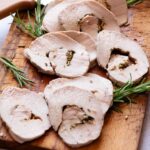Italian Roast Pork Loin with Amalfi Lemon & Fennel
How to make the most delicious Italian Roast Pork Loin stuffed with Amalfi lemon, fennel, white wine and garlic. Roasted to perfection it's juicy, tender and full of flavour. Serve with roast potatoes or your favourite Italian side dish.
Servings: 6 servings
Calories: 226kcal
Equipment
- Plastic wrap (cling film)
- Kitchen string
- Meat mallet or rolling pin
- A damp and crinkled piece of baking parchment for covering the pork
- Aluminium foil
Ingredients
- 1 kg pork loin (weight is after fat removed, see note 1)
- 1 pinch chilli flakes (red pepper flakes)
- ½ Amalfi lemon peel or other unwaxed lemon
- 1 teaspoon oregano
- 1 teaspoon rosemary
- 1 teaspoon fennel seeds
- 2 garlic cloves finely grated or minced
- 1 large onion or 2 small
- 1 tablespoon Italian white wine (e.g Vermentino, Pinot Grigio, Pecorino)
- Olive oil
- Sea salt flakes and black pepper
Instructions
- Pre-heat the oven to 180C (350F).
- Cut the pork loin down the middle lengthways so it’s open like a book (don’t cut right the way though it should still be one whole piece). Place a piece of plastic wrap over the pork and bash the pork with a meat mallet or rolling pin a few times all over to tenderise the meat and make it an even thickness. Discard the plastic wrap.
- Using a mezzaluna or knife finely chop the lemon zest and rosemary together.
- Sprinkle the pork with sea salt flakes (you can also use regular salt) then sprinkle over the lemon zest, rosemary, grated garlic, oregano, red pepper flakes and a pinch of black pepper. Finally, drizzle the white wine and olive oil (1 teaspoon) over the pork and rub everything together.
- Tightly roll the pork lengthways from one end to the other and secure it with kitchen string. You can do this by tying loops of string at each end then about ½ an inch apart across the pork (see our step-by-step photos and recipe video for tying up the pork using butcher's knots, see note 3).
- Once the pork is secure with kitchen string sprinkle more sea salt flakes and fennel seeds over the top of the meat and drizzle with 1 tablespoon of olive oil and rub it all over.
- If you have time place the pork in the fridge for 2 hours to overnight to infuse the flavours but it can be roasted right away.
- Thickly slice the onion and place in a roasting tin as a bed for the pork to sit on. Place the pork on top and cover with the baking parchment.
- Roast for 30 minutes covered then remove the baking parchment and roast for another 40 minutes uncovered.
- Remove from the oven, cover with foil and let it rest for 20 minutes before slicing and serving.
Video
Notes
-
- Pork weight - 1kg/2lbs is the weight of the pork with the fat removed. If you buy a pork loin with the fat attached you'll need a 1.5kg/3.3lb piece of meat.
- Trimming the sinew (silver skin) - after you have removed the thick layer of fat you'll need to remove any remaining sinew so you have a lean piece of meat. To do this, keep your knife level when trimming the sinew so you don't dig into the loin and cut the meat (a sharp knife helps).
- Tying the pork - there are two ways you can tie the pork. You can tie it using butcher's knots which keep the meat secure and in shape or by simply tying loops across the length of the pork. Don't worry about being able to use butcher's knots too much, the important thing is that the pork is secure.
- Using a bed of onions - this not only adds flavour to the pork but it's important for roasting the pork evenly. Cut 1-2 onions in thick slices (about ½ inch thick) removing the round ends so the pork sits level.
- Baking parchment - scrunch the baking parchment in your hands then run it under cold water to dampen it. This will create a cartouche for the pork, keeping the moisture in without overcooking it.
- Resting the pork - it’s so important to rest the meat to allow the juices to absorb back into the meat keeping it juicy and flavourful. Don’t worry it will still be hot.
- Storage & freezing - The roast pork will keep well in the fridge for 3-4 days or can be frozen.
Nutrition
Calories: 226kcal | Carbohydrates: 1g | Protein: 37g | Fat: 7g | Saturated Fat: 2g | Polyunsaturated Fat: 1g | Monounsaturated Fat: 3g | Cholesterol: 105mg | Sodium: 83mg | Potassium: 640mg | Fiber: 0.4g | Sugar: 0.1g | Vitamin A: 12IU | Vitamin C: 1mg | Calcium: 21mg | Iron: 1mg
